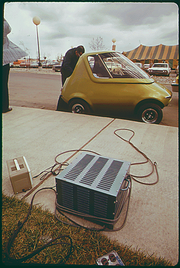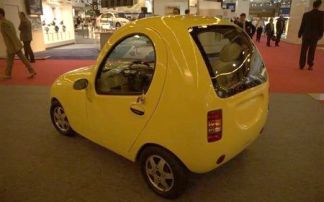Categories: Featured Articles » Controversial issues
Number of views: 36849
Comments on the article: 3
A subjective look at an affordable modern electric car
 This article is created due to the fact that there are many completely unjustified views on the current state of the problem of electric transport. Unjustified hopes lead to disappointment and rejection of the very idea of clean transport. These sentiments are in full support of opponents of electric vehicles, which are not so much numerous as influential (the world is sitting on the "oil and gas needle" and this dependence has long been a narcotic ...).
This article is created due to the fact that there are many completely unjustified views on the current state of the problem of electric transport. Unjustified hopes lead to disappointment and rejection of the very idea of clean transport. These sentiments are in full support of opponents of electric vehicles, which are not so much numerous as influential (the world is sitting on the "oil and gas needle" and this dependence has long been a narcotic ...).
First you need to decide on the modern realities and objectives of the introduction of electric vehicles. Already driving an electric car is not only environmentally friendly, but also financially beneficial. The main argument against the electric car is a small range on one charge of the battery. This shortcoming is more than compensated by the fact that most intercity trips are made in the “to work - home” cycle and, on average, transfers are carried out at 25-30 km per day, with an average of 1.3 people being transported. Therefore, we will determine that a modern electric car is a means for urban communication in medium and small cities.
When using lead-acid traction batteries, as the most affordable at the moment, the weight of the battery to achieve a maximum range of 60 km is from 200 to 300 kg, depending on the mass and aerodynamic properties of the electric vehicle. It should be noted that lead-acid batteries are conditionally environmentally friendly - the recycling has been worked out and debugged for a long time, it is enough not to throw the spent batteries into a landfill. Batteries are the main consumables during operation, so the issue of reducing the number of batteries while maintaining the range is very acute.
For the actual use of an electric vehicle, it is desirable that it be as cheap as possible. The cost of operating an electric car is lower than the cost of operating a car with an internal combustion engine in the city at times, but if the electric car itself will cost more than a mini-car, then who will use the electric car?
Due to the mass and overall characteristics, it is desirable that the electric car is not a rework of a production car with an internal combustion engine (which is currently being attempted by the large auto industry because of the desire to bury the idea of an electric car in its infancy, and numerous electric vehicle enthusiasts do because of the possibility remake cheap affordable used car body on wheels in a full-fledged environmentally friendly transport). The purpose of the electric vehicle dictates a slightly different approach to the construction of serial samples - simpler and cheaper.
The described limitations dictate the appearance of a modern affordable electric car:
-
supporting safety cage (an idea tested by time on sports buggies provides excellent passive safety with a minimum of investment)
-
case made of plastic hinged panels - provides a long life without worrying about corrosion, painting, and also provides a lower weight
-
double layout
-
limiting the maximum speed to 70-90km / h (the limitation is dictated by the limitation of the speed of movement around the city and allows you to use a cheaper and lighter electric motor, as well as extend the mileage by reducing aerodynamic drag)
-
the total weight of the electric car without a load is 400-500 kg, the payload is up to 250 kg (the less the weight, the less the battery capacity on board to ensure the same mileage; the less the required capacity, the cheaper the operation)
-
electric motor, with a rated load of 4-5KW and peak up to 20KW
-
power controller, providing the possibility of regenerative braking (the range is increased, the brake system wears out less)
-
maximum power reserve on one charge 40-60km (if you can recharge at both ends of the route, you can limit yourself to a smaller power reserve)
-
relatively less comfort - the absence of an air conditioner, interior heating with a low-power heater (on some serial electric vehicles, the heating problem is solved by introducing an additional paraffin or gas heater for the winter season), the absence of a power steering and a vacuum brake booster
-
mileage equivalent to a hypothetical car with an internal combustion engine consuming 2-3 liters of gasoline per 100 km (the cost of a trip to work, comparable to the cost of a trip in public transport, with all the advantages of a personal car)
-
cost less than 5000USD
You can say that the provisions described in the article are an unrealizable utopia, and - you make a mistake - a large number of serial electric vehicles with the indicated parameters are currently being produced. The only stumbling block is the price (the cheapest mass-produced electric cars cost starting from 8000-10000USD). Come back in a few weeks - on the website there will be descriptions of the most successful serial electric vehicles.
An example of an inexpensive mass-produced electric car:
Chinese Tang Hua Xiao Ya created the first Chinese electric car. The cost of such a car is only $ 5000. This Chinese car can travel at speeds of 28 to 40 miles per hour. Chinese automakers are placing big bets on this type of car. And they say that the era of green electric cars in China has already begun. At the moment, several more cars of this class are being developed.
See also at bgv.electricianexp.com
:

